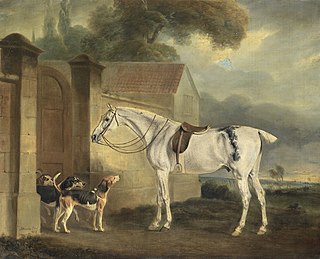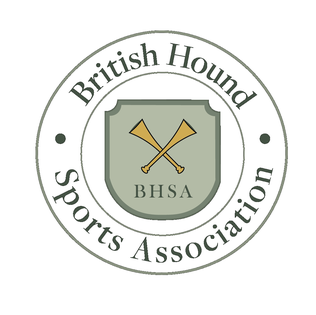
Fox hunting is an activity involving the tracking, chase and, if caught, the killing of a fox, normally a red fox, by trained foxhounds or other scent hounds. A group of unarmed followers, led by a "master of foxhounds", follow the hounds on foot or on horseback.
The League Against Cruel Sports, formerly known as the League for the Prohibition of Cruel Sports, is a UK-based animal welfare charity which campaigns to stop blood sports such as fox hunting, hare and deer hunting; game bird shooting; and animal fighting. The charity helped bring about the Hunting Act 2004 and Protection of Wild Mammals (Scotland) Act 2002, which banned hunting with hounds in England, Wales and Scotland.

Beagling is mainly the hunting of hares and rabbits by beagles using their strong sense of smell. A beagle pack is usually followed on foot, but in a few cases mounted. Beagling is often enjoyed by 'retired' fox hunters who have either sustained too many injuries or lost the agility to ride horseback, or who enjoy the outdoors and the camaraderie of the hunt. It is also traditionally a way for young men and women to learn how to handle hounds on a smaller scale before they go on to hunt with foxhounds.

Drag hunting or draghunting is a form of equestrian sport, where mounted riders hunt the trail of an artificially laid scent with hounds.

The Hunting Act 2004 is an Act of the Parliament of the United Kingdom which bans the hunting of most wild mammals with dogs in England and Wales, subject to some strictly limited exemptions; the Act does not cover the use of dogs in the process of flushing out an unidentified wild mammal, nor does it affect drag hunting, where hounds are trained to follow an artificial scent.

Brixworth is a village and civil parish in West Northamptonshire, England. The 2001 census recorded a parish population of 5,162, increasing to 5,228 at the 2011 census. The village's All Saints' Church is of Anglo-Saxon origin.

The Duke of Beaufort's Hunt, also called the Beaufort and Beaufort Hunt, is one of the oldest and largest of the fox hunting packs in England.
Legislation on hunting with dogs is in place in many countries around the world. Legislation may regulate, or in some cases prohibit the use of dogs to hunt or flush wild animal species.

The Berkeley Hunt is a foxhound pack in the west of England. Its country lies in the southern part of Gloucestershire, between Gloucester and Bristol.

The Protection of Wild Mammals (Scotland) Act was an Act of the Scottish Parliament passed in February 2002, making Scotland the first part of the United Kingdom to ban traditional fox hunting and hare coursing. It was repealed in 2023.

West Northamptonshire is a unitary authority area in the ceremonial county of Northamptonshire, England, and was created in 2021. It contains the county town of Northampton, as well as the towns of Daventry, Brackley and Towcester, and the large villages of Brixworth and Long Buckby; the rest of the area is predominantly agricultural villages though it has many lakes and small woodlands.

The Quorn Hunt, usually called the Quorn, established in 1696, is one of the world's oldest fox hunting packs and claims to be the United Kingdom's most famous hunt. Its country is mostly in Leicestershire, together with some smaller areas of Nottinghamshire and Derbyshire.

The Cottesmore Hunt, which hunts mostly in Rutland, is one of the oldest foxhound packs in Britain, with origins dating back to 1666. Its name comes from the village of Cottesmore where the hounds were kennelled.
The Crawley and Horsham Hunt is a United Kingdom foxhound pack, with hunting country of around 23 miles by 20 miles within the ceremonial county of Sussex.
The Woodland Pytchley Hunt is a foxhound pack based in Northamptonshire. The Pytchley Hunt country used to include areas of the Rockingham Forest but was split to form the Woodland Pytchley Hunt.

Trail hunting is a legal, although controversial, alternative to hunting animals with hounds in Great Britain. A trail of animal urine is laid in advance of the 'hunt', and then tracked by the hound pack and a group of followers; on foot, horseback, or both.

The Vale of the White Horse Hunt is a fox hunting pack that was formed in 1832. It takes its name from the neighbouring Vale of White Horse district, which includes a Bronze Age horse hill carving at Uffington.

The Warwickshire Hunt is an English fox hunting pack founded in 1791.

The British Hound Sports Association (BHSA) is the governing body for many hound sports associations in Great Britain. However, it is not the governing body for either draghound packs or bloodhound packs who are governed by the Master of Draghound & Bloodhounds Association (MDBA). The BHSA is responsible for setting standards and rules to which members and registered hunts are supposed to adhere. A sister organisation, the Hound Sports Regulatory Authority (HSRA), is responsible for regulatory and disciplinary matters for members and member hunts, in accordance with rules set by the BHSA.
















